By Andrew Karp: Group Editor, Lenses and Technology
NEW YORK—If you ask an eyecare professional what are the latest trends in ophthalmic lenses, you’ll probably get an earful about digital and free-form design, customization, and personalization. Although many ECPs prescribe and dispense these sophisticated lenses, most are unaware of the digital processing technology needed to produce the lenses.
Laboratory owners and operators, though, are acutely aware of the impact digital lens processing is having on their businesses. The cost of installing the technology is considerable, and the learning curve steep. However, many lab owners believe the added expense and effort is well worth it because of the gains in speed, accuracy and efficiency their labs derive.
VM asked executives from six optical labs (the sixth profile can be found at visionmonday.com)—five independent wholesalers and one integrated retail chain—to describe the process of “going digital” and explain how the new technologies are transforming their lab’s operations, workforce, inventory, product mix and service. They also discussed the up-front investment that is required for a digital lab and the expected return on that investment.
Investment Pays off in Efficiencies
EXPERT OPTICS Shorewood, Ill.
Like all labs that have taken the plunge into digital surfacing, Expert Optics has found the process challenging. “I’ve yet to see a plug and play system,” said lab president Greg Ruden, who admits that the lab has experienced a considerable amount of lens breakages while learning the intricacies of digital technology. “It isn’t something that runs by itself,” noted Ruden. “Every day you’ve got to make sure everything is calibrated. If you’re not paying attention, 40 jobs can get ruined.”
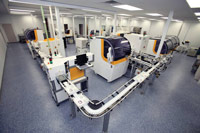
|
| Expert Optics’ new Satisloh OBM lab, featuring a “no touch” production line. |
The Expert Optics management team has learned a lot since deciding to install Satisloh generators and polishers in October, 2007. After three months of testing, the lab started processing Shamir Autograph free-form lenses.
“One of our biggest concerns was making sure we were integrated with DVI,” said Ruden, referring to Digital Vision Inc., a leading supplier of LMS software and systems. “For every lens manufacturer’s back surface progressive, you have to have a black box [computer] with the lens coordinates, or points file. If you’re not integrated with your LMS, you have to physically program coordinates for each job.”
Ruden said one of the immediate benefits of digital surfacing was being able to streamline the surfacing room staff. “We went from a six- or seven-person surfacing room down to one and a half or two people,” he noted.
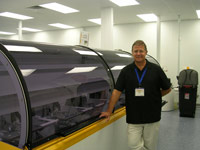
|
Expert Optics' lab manager Bob Pommier shows off a new Satisloh sputter coating machine in the company's speed lab.
|
Another benefit has been an improved workflow. “The system tells the lens pickers what department the job is going to. It’s also helped a lot with our lens inventory. Instead of having a $40 progressive on the shelf, you have a pair of three dollar lenses. I don’t stock 75 adds or ever 3.50 adds. I was always ordering those lens blanks. Now we can make them ourselves.”
Ruden said that digital surfacing not only allows Expert Optics to produce lenses with 10 times better optics than traditional surfacing, but to do it much faster as well.
“The turnaround we’ve been able to provide clients is having a huge impact,” he said. “Now, we run the jobs through so quickly. If a doctor sends in an order late Friday afternoon and calls Monday morning to cancel it, we’ve already processed the job.”
Expert Optics’ investment in digital is paying off more quickly than Ruden anticipated. “Initially, I thought we’d have a five- to seven-year payback, but now it looks more like it’s going to be three to five years.
Ruden noted that installing digital surfacing may require an expansion of the lab, which adds considerably to the cost. “We had to build out our surface room for our new speed lab, which was a half million dollar investment,” he said.
Ruden is especially proud of the speed lab, which began operating last month. Featuring Satisloh’s proprietary OBM (On-Block Manufacturing) technology, it is the first no-touch production line in the US. “I thank [lab manager] Bob Pommier for staying on the bleeding edge of technology,” he said.
Mike Fussell, Robertson Optical’s sales and customer service manager, gets excited talking about the new capabilities that digital surfacing has brought to the company’s lab, located in Loganville, Georgia, near Atlanta.
As Technology Changes, So Do Employees
RITE-STYLE OPTICAL Omaha, Neb.
In 2006, Rite-Style Optical became the first independent lab in the country to “go digital” when it integrated its Lab Management System (LMS) with a Robotic High Production HSC Master and CCP Polishers it purchased from Schneider Optical Machines. Within a short period of time, the lab found it necessary to invest in more digital equipment due to increased demand, according to general manager Mike Sutton.
“The software systems we employ did not adversely change how we operate because of the advent of digital production,” Sutton recalled recently. “What did change was the coordination necessary between Rite-Style, the lens manufacturers, the equipment manufacturers and the LMS.” Sutton noted that the installation of a conveyance system was paramount to the efficiency of the robotic processing equipment.
Changes in inventory management became apparent only in the last year or so, Sutton said. “The amount of single vision blanks specific to free-form processing has certainly displaced the amount of conventional progressives that are inventoried,” he observed.
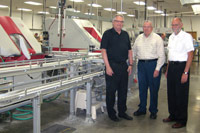
|
| (L to R) Mike Sutton, George Lee and Ray Stavneak in the Rite-Style digital surfacing department. |
Although the amount of labor needed to maintain the digital/robotic systems is considerably less than conventional processing, Sutton said increased demand has allowed Rite-Style to maintain its production staff without any layoffs due to the new technology. However, the qualifications that are necessary for employees have changed with the digital technology.
“Computer-savvy technicians with a mechanical background replaced machine operators who processed lenses,” Sutton pointed out. “Maintenance and calibration is paramount to successful free-form digital production,” he added.
Rite-Style uses digital surfacing to produce 85 percent of its lenses, according to Sutton. He defines digital lens surfacing as “any lens that is digitally surfaced either with two meridians of curves—atoric curves to enhance front PAL (progressive addition lens) designs or total backside, digitally surfaced free-form lens design.”
As digital surfacing took hold at Rite-Style, the company had to provide more training for its customer service reps. “One learning curve for the ECP is the understanding of ‘as worn’ technology and the relationship of fixed versus variable corridor, the ‘B’ measurement and add power,” Sutton noted.
Despite the large upfront investment required for digitally surfacing free-form lenses, Sutton said independent labs such as Rite-Style need to do it to remain competitive. “The ROI is in getting a greater profit margin on the free-form lenses,” he said, adding that the cost of the lenses decreases when factoring in less breakage and fewer remakes that result from digital’s greater accuracy.
Cutting Edge Upgrades Mean Better Service
ROBERTSON OPTICAL OF ATLANTA Loganville, Ga.
“I’ve been in this business for about 34 years, and this is really fun,” said Fussell. “I’ve already seen a blended myodisc done on minus eight on six-base curve that looked like a minus three. Down the road, we’re going to see things that will be mind boggling.”
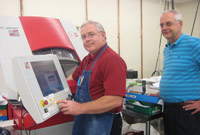
|
| Robertson Optical’s surfacing room manager John Westbrooks (l) with sales and customer service manager Mike Fussell. |
Robertson is a relatively recent convert to digital surfacing, having purchased equipment and begun production in the fourth quarter of 2009. The lab is running Schneider equipment and C.C. Systems LMS, which is integrated with Shamir’s Prescriptor system, the calculation engine for Shamir Autograph free-form lenses.
Part of the challenge with selling free-form lenses is educating the lab’s accounts about the differences between free-form and conventional lenses, Fussell said. “When we get calls from customers, they understand they’re going to get a compensated power because of position of wear technology. They know they can’t read it exactly on a lensometer.
“I have seen compensated axis that is different by as much as 10 or 12 degrees,” Fussell continued. We give them a compensation sheet that shows them what it’s supposed to be. Our customers are very trusting, though, because they know our quality. Over time, the retail community will invest in digital machines that will do a better job of verifying the prescriptions. But as of now, the cart is before the horse.”
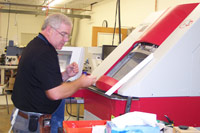
|
John Westbrooks, surfacing manager of Robertson Optical Laboratories of Atlanta, is shown here producing a pair of Robertson's private label Coze lenses.
|
Like other lab managers who have embraced digital surfacing, Fussell attests to the fact that the learning curve is steep at first. “The machinery is a good bit more complicated,” he said. “Our surface manager spent a good part of the first 120 days literally doing it all himself and looking at every job. He had to look at the laser engraving and make adjustments, because dip coating as well as different materials and lens designs affects the depth of the engraving. For example, Zeiss is different than Shamir.”
Fussell credits the digital technology with significantly improving Robertson’s ability to service its accounts. The ability to make a lens on demand rather than having to pull it from stock or else order it is a big plus, he said.
“Now, the materials are always on the shelf,” noted Fussell. “For example, in the summertime, a patient might be going on vacation and need a Transitions Brown 1.67 in a 3.50 add. Not too many labs have that on the shelf. With digital, you can get started on it right away and save a day or day-and-a-half. You can also take that puck [lens blank] and make it into four or five different lens designs. You look through charts and say, “Maybe Zeiss has got some product extensions that they didn’t have in traditional areas that we can make. The sky’s the limit.”
Robertson also uses digital surfacing to create private label lenses. The lab recently introduced Cozē, its own brand of customized, free-form progressive lenses which feature what Robertson calls Customized Optical Zone Enhancement.
“Cozē progressive lenses exceed the performance of conventional premium progressives, and do it at a moderate price,” said Fussell, adding that Robertson also offers Cozē HDW for seasoned progressive lens wearers and Cozē Single Vision which features an atoric digital back curve and outperforms standard single vision lenses, according to Fussell.
Manufacturing Improvements Boost Margins
ACCURATE OPTICAL Salisbury, Md.
Accurate Optical, a six-unit optical chain based in Salisbury, Maryland, recently entered the digital lens-manufacturing arena when it installed Gerber Coburn’s Advanced Lens Processing System (ALPS) and a Simplimatic automation module in its central lab. The ALPS system consists of a Gerber Coburn DTL200 generator paired with two MAAT polishers. Accurate Optical also changed the lab’s blocking process from a wax based “freebond” to alloy.
The addition of the new hardware and technology required an improvement in the lab’s Lab Management System (LMS), company CEO Stephen L. Franklin pointed out. “After installing the new equipment and interfacing with various manufacturer’s software suites, we decided to add C.C. Systems’ Labzilla to our lab to better integrate our digital capabilities into our lab,” he said.
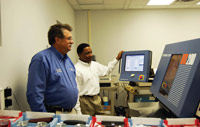
|
| Accurate Optical’s regional manager Robert Murphy (l) and CEO Stephen Franklin, inspect their lab’s new Gerber Coburn DTL200 generator. |
Some changes to the lab’s workflow were also necessary, Franklin noted. “By adding the DTL200, our cut-to-polish time has been greatly reduced, and although we now have the additional curing time for the alloy, we are able to continue providing same or next day service to all of our locations as before. Some minor construction was necessary to allow for power and other infrastructure improvements such as air, water, drainage, and IT/network connectivity, and we made a minor modification to one wall to allow for passage of a conveyor that runs from our blocker to the generator.”
Inventory management has been improved since Accurate’s lab went digital. “By expanding the range of possible finished prescriptions from a much smaller group of SKUs we have been able to reduce our lens inventory by 60 percent,” Franklin said. “We still stock multiple materials and lenses with various options, but we stock many fewer lenses of each type because our manufacturing capabilities allow us to make many more prescriptions from a single lens blank.”
The new technology also helped Accurate reduce its labor costs. “It is a horrible time to lay off productive members of your team, but this technology created such efficiency in our operation, that we were able to reduce our manufacturing team from nine full-time employees to five,” said Franklin. “The transition was challenging, but now that the dust is settling, we are finding that we have the right number of associates in our lab and the payroll savings is being applied to the debt service financing for the equipment purchase.”
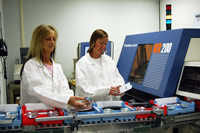
|
Lab technicians Linda Strouth (l) and Tracy Holloway, check lenses being loaded into a Gerber Coburn DTL200 generator.
|
The digital technology allows Accurate Optical to produce the Seiko Pentax Perfas line of digital lenses, while continuing to produce conventional single vision, bifocal and progressive lenses. Franklin said Accurate Optical has been able to control its branded choices by controlling its inventory.
Accurate Optical’s capital investment for going to the digital system was around $600,000, including minor infrastructure improvements and construction modifications, according to Franklin.
“This manufacturing improvement will increase our margins on the sale of digital product by around $50 per pair,” he said. “Prior to the installation, we were selling around 350 pairs of digital progressives monthly. By lowering our manufacturing costs, reducing personnel costs, and improving the turnaround time to our locations, we have generated positive cash flow in the manufacturing division from the first day.”
Yet Franklin cautions that a lab’s decision of whether or not to go digital must be made on a case-by-case basis. “This particular solution made sense for us because our traditional equipment was aging, and we were looking at a significant capital investment anyway,” he said.
“It was the perfect time to make a slightly larger investment and become the first independent optometric group practice to have this capability in house. Is this approach for everyone? Absolutely not. Practices should look at their production and their margins and arrive at a decision that makes sense for them,” Franklin advised.
Careful Budgeting and Planning Offset Risks
NEXUS OPTICAL Columbus, Ohio
On April 10, Nexus Vision Group hosted a reception at its lab near Columbus, Ohio to celebrate the opening of its new digital lens processing facility. The event was eagerly anticipated by the Nexus management team and the lab’s employees, which had successfully worked through a complex and, at times, difficult startup phase.
“We started Nexus to do free-form,” said Gerry Shaw of Western Carolina Optical, who serves as head of the Nexus Vision Group, a collective consisting of eight independently owned labs located throughout the Southeastern U.S., Nexus services not only its own members’ labs but other labs as well.
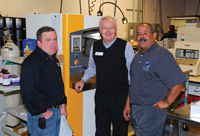
|
| Inspecting a Satisloh MagnaSpin 2SV coater at Nexus Vision’s open house are (l to r) Pete Mayrand, lab manager at Western Carolina Optical, Bruce Brady, executive director of Optical Synergies, and Juan Pesante, general lab manager of the Nexus Vision Group. |
“Five years ago, when we first looked at digital surfacing, the technology was still in its infancy. When it was finally time to pull trigger, we looked at many machines in action, as well as various LMS systems. Then we did some forecasts of what we’re going to be able to do, looked at click fees and put together a budget for whole project.”
Shaw and his colleagues at Nexus decided to invest in Satisloh digital surfacing equipment and a Santinelli edging system.
“The process of going digital is not plug and play by any means,” Shaw remarked. “It takes a lot of planning time and money to bring it all together when you’re starting from scratch.
Shaw noted that a lot of planning was involved in making sure the lab’s infrastructure was adequate to handle considerable electrical power needs of the machinery. The data management side is equally complex, according to Shaw. “The amount of computing power we need to make all this work was fairly mindboggling,” he said. “I’ve got basically one server handling my lab work, but I also have 15 computers, one for every vendor. The LMS from DVI requires a number of computer with adequate backup. There’s a data line for each piece of equipment running back to the main servers.”
With digital lens production now in full swing, Nexus is benefiting from the improved efficiency.
“The machinery is much more efficient than standard surfacing,” marveled Shaw. “It’s amazing how many jobs you can do.”
Nexus is producing two licensed brands of progressives, Shamir Autograph and Seiko free-form as well as Proprius, a private label brand. With the three lenses positioned at different price points, Nexus is able to offer its accounts a choice of good, better and best.
“We’re able to purchase that lens at a more reasonable click fee, and it provides us with a better margin,” noted Shaw. “Anytime we get a doctor requesting our lens, it makes us feel safer in this economy.”
Nexus’s investment in digital is “a little north of one million dollars,” said Shaw, adding that it’s early to say when the lab will break even. “We’re taking some major risks in a down economy,” he said. “But we’re confident this is an investment in the future.”
■
■
Andrew Karp
akarp@jobson.com